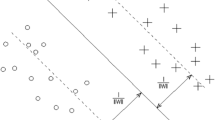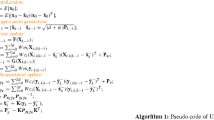Abstract
As an effective learning technique based on structural risk minimization, SVM has been confirmed an useful tool in many machine learning fields. With the increase in application requirement for some real-time cases, such as fast prediction and pattern recognition, the online learning based on SVM gradually becomes a focus. But the common SVM has disadvantages in classifier’s bias and the computational complexity of online modeling, resulting in the reduction in classifier’s generality and the low learning speed. Therefore, an non-biased least square support vector classifier(LSSVC) model is proposed in this paper by improving the form of structure risk. Also, a fast online learning algorithm using Cholesky factorization is designed based on this model according to the characteristic of the non-biased kernel extended matrix in the model’s dynamic change process. In this way, the calculation of Lagrange multipliers is simplified, and the time of online learning is greatly reduced. Simulation results testify that the non-biased LSSVC has good universal applicability and better generalization capability, at the same time, the algorithm has a great improvement on learning speed.





Similar content being viewed by others
References
Suykens JAK, Vandewalle J (1999) Least square support vector machines classifiers. Neural Process Lett 9(3):293–300
Ralaivola L (2001) Incremental support vector machine learning: a local approach. In: Proceedings of the international on conference on artificial neural networks, Vienna, Austria. pp 322–329
Ruping S (2002) Incremental learning with support vector machines. Dortmund University, Dortmund: Technical Report TR 18
Shilton A, Palaniswami M, Ralph D, Tsoi AC (2005) Incremental training of support vector machines. IEEE Trans Neural Netw 16(1):114–131
Lau KW, Wu QH (2003) Online training of support vector classifier. Pattern Regres 36(8):1913–1920
Ma J, Theiler J, Perkens S (2003) Accurate on-line support vector regression. Neural Comput Appl 15:2683–2703
Kivinen J, Smola AJ, Williamson RC (2004) Online learning with kernels. IEEE Trans Signal Process 52:2165–2176
Vishwanathan SVN, Schraudolph NN, Smola AJ (2006) Step size adaptation in reproducing kernel Hilbert space. J Mach Learn Res 7:1107–1133
Martin M (2002) Online support vector machines for function approximation. Politecnica University, Catalunya, Spain: Technical Report LSI-02-11-R
Zhang HR, Wang XD (2006) Incremental and online learning algorithm for regression least square vector machine. Chin J Comput 29(3):400–406
Fan YG, Li P, Song ZH (2006) Dynamic weighted least square support vector machines. Control Decis 21(10):1129–1133
Suykens JAK, Vandewalle J (2000) Recurrent least squares support vector machines. IEEE Trans Circuits Syst 47(7):1109–1114
Cesa-Bianchi N, Conconi A, Gentile C (2004) On the generalization ability of on-line learning algorithms. IEEE Trans Inf Theory 50(9):2050–2057
Crammer K, Dekel O, Keshet J, Shalev-Shwartz S, Singer Y (2006) Online passive-aggressive algorithms. J Mach Learn Res 7:551–585
Fung G, Mangasarian O (2001) Proximal support vector machine classifiers In: Proceedings KDD-2001, knowledge discovery and data mining, San Francisco, CA
Fung G, Mangasarian O (2001) Incremental support vector machine classification, Data Mining Institute Technical Report 01-08. Computer Sciences Department, University of Wisconsin
Liu QG, He Q, Shi ZZ (2007) Incremental nonlinear proximal support vector machine. In: Proceedings of ISNN’07 4493: 336C341
Gene HG, Charles FV (1996) Matrix computations. The Johns Hopkins University Press, Maryland
Seeger M (2005) Low Rank Updates for the Cholesky Decomposition. Technical Report, Max Planck Society, Tuebingen, Germany
Ojeda F, Suykens JAK, Moor BD (2008) Low rank updated LS-SVM classifiers for fast variable selection. Neural Netw 21:437–449
Vijayakumar S (1999) Sequential support vector classifiers and regression. In: Proceedings of international conference on soft computing, Genoa, Italy. pp 610–619
Zhang HR, Zhang CJ, Wang XD (2006) A new support vector machine and its learning algorithm. In: Proceedings of the 6th world congress on control and automation, Dalian, China. pp 2820–2824
Engel Y, Mannor S, Meir R (2002) Sparse online greedy support vector regression. In: Proceedings of European conference on machine learning. Spring, Berlin, pp 84–96
Csato L, Opper M (2002) Sparse on-line Gaussian processes. Neural Comput Appl 14(3):641–668
Navia-Vzquez A, Prez-Cruz F, Arts-Rodriguez A, Figueiras-Vidal A (2004) Unbiased support vector classifiers. In: Proceedings of the IEEE signal processing society workshop. pp 183–192
Navia-Vzquez A, Prez-Cruz F, Arts-Rodriguez A, Figueiras-Vidal A (2004) Advantages of unbiased support vector classifiers for data mining applications. J VLSI Signal Process 37:223–235
Zheng DL (2006) Research on kernel methods in machine learning. Ph.D. thesis, Tsinghua University
Wang HQ, Sun FC, Zhao ZT, Cai YN (2007) SAR image ATR using SVM with a low dimensional combined feature. In: Proceedings of SPIE MIPPR’07 6786:67862J
Debnath R, Takahide N, Takahashi H (2004) A decision based one-against-one method for multi-class support vector machine. Pattern Anal Appl 7(2):164–175
Acknowledgments
This work was jointly supported by the National Science Fund for Distinguished Young Scholars (Grant No: 60625304), the National Natural Science Foundation of China (Grants No: 60621062, 60504003), the National Key Project for Basic Research of China (Grant No: 2007CB311003) and the Specialized Research Fund for the Doctoral Program of Higher Education (Grant No: 20050003049).
Author information
Authors and Affiliations
Corresponding author
Rights and permissions
About this article
Cite this article
Wang, HQ., Cai, YN. & Sun, FC. A non-biased form of least squares support vector classifier and its fast online learning. Neural Comput & Applic 20, 1075–1085 (2011). https://doi.org/10.1007/s00521-010-0517-y
Received:
Accepted:
Published:
Issue Date:
DOI: https://doi.org/10.1007/s00521-010-0517-y




